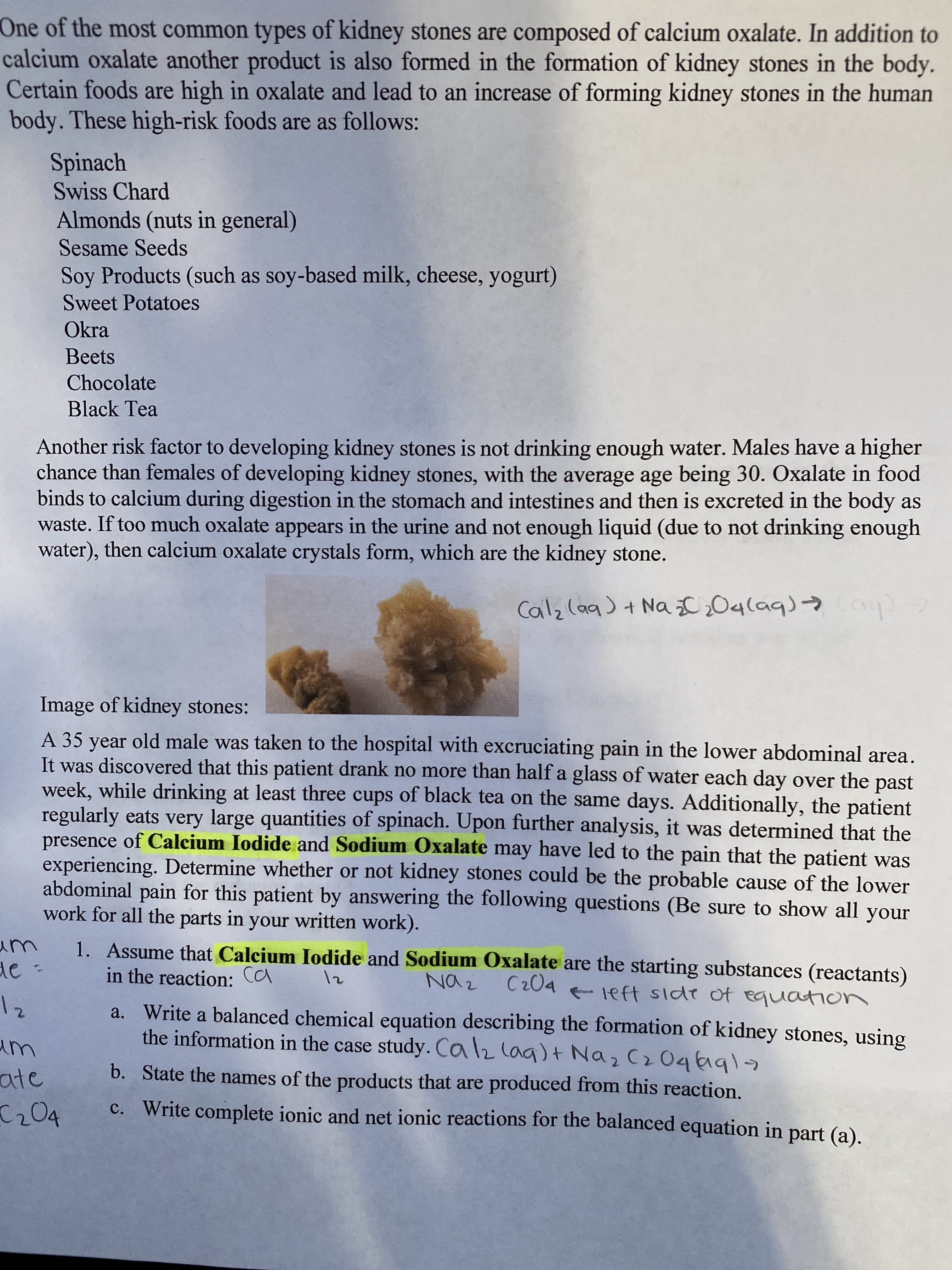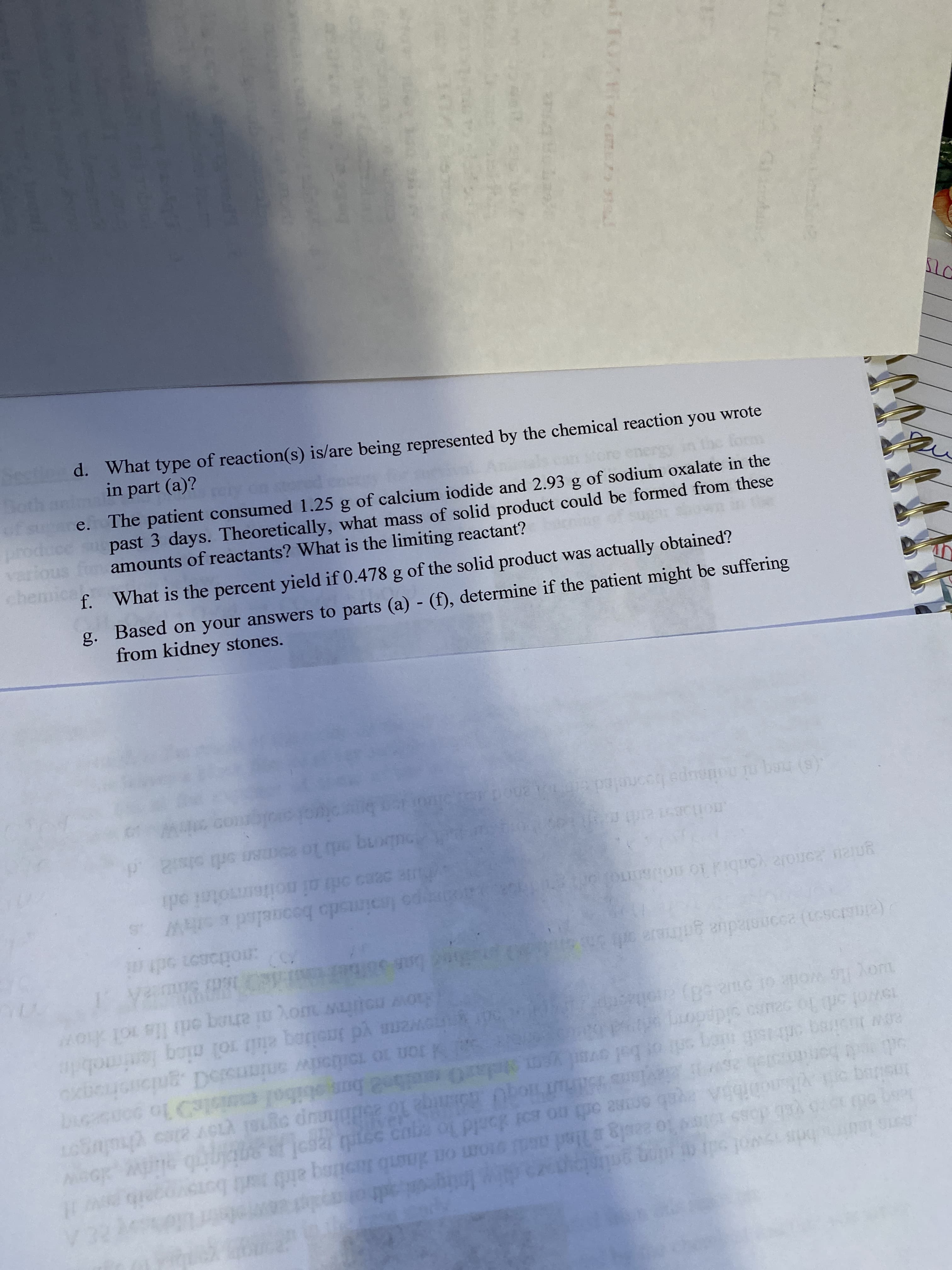One of the most common types of kidney stones are composed of calcium oxalate. In addition to calcium oxalate another product is also formed in the formation of kidney stones in the body. Certain foods are high in oxalate and lead to an increase of forming kidney stones in the human body. These high-risk foods are as follows: Spinach Swiss Chard Almonds (nuts in general) Sesame Seeds Soy Products (such as soy-based milk, cheese, yogurt) Sweet Potatoes Okra Beets Chocolate Black Tea Another risk factor to developing kidney stones is not drinking enough water. Males have a higher chance than females of developing kidney stones, with the average age being 30. Oxalate in food binds to calcium during digestion in the stomach and intestines and then is excreted in the body as waste. If too much oxalate appears in the urine and not enough liquid (due to not drinking enough water), then calcium oxalate crystals form, which are the kidney stone. Calzlaa) + Na C04laq) ag)7 Image of kidney stones: A 35 year old male was taken to the hospital with excruciating pain in the lower abdominal area. It was discovered that this patient drank no more than half a glass of water each day over the past week, while drinking at least three cups of black tea on the same days. Additionally, the patient regularly eats very large quantities of spinach. Upon further analysis, it was determined that the presence of Calcium Iodide and Sodium Oxalate may have led to the pain that the patient was experiencing. Determine whether or not kidney stones could be the probable cause of the lower abdominal pain for this patient by answering the following questions (Be sure to show all your work for all the parts in your written work). 1. Assume that Calcium Iodide and Sodium Oxalate are the starting substances (reactants) in the reaction: Ca de- 12 Na 2 C204 E left sidt of equation 12 a. Write a balanced chemical equation describing the formation of kidney stones, using the information in the case study. Ca l2 lag)+ Na2 C204aql ate b. State the names of the products that are produced from this reaction. C204 c. Write complete ionic and net ionic reactions for the balanced equation in part (a). Sestl Bo of d. What type of reaction(s) is/are being represented by the chemical reaction you wrote in part (a)? e. The patient consumed 1.25 g of calcium iodide and 2.93 g of sodium oxalate in the past 3 days. Theoretically, what mass of solid product could be formed from these amounts of reactants? What is the limiting reactant? van chem g. Based on your answers to parts (a) - (f), determine if the patient might be suffering from kidney stones. f. What is the percent yield if 0.478 g of the solid product was actually obtained? t 200d (s) neq ni naitsupa booneled noitaart Ane seno ordi ai no po Iainsdo beoneled orhW temotai odi LCUcpou: anpucca (LCSCE2) moitason odt m ow notinw woy ni aneq erii Ila ot how dr owznn yd inong eit rol ninq lenimobile Jom oy le work of ome o8) aroitacr 19ol or lo sauso oldedom o 2ow Juieg orNs nieg 2om De Vis ut ioqU Boinige 16 25bhaup ogal or ahes hulugon 2 o no sot doald lo equo sl t2o lo 2aslg llad audi orom on inab Jasitsq aidb a ban sbibol eaiolc lo talar0 lbo2 cara ACLA Insituq nchibl
One of the most common types of kidney stones are composed of calcium oxalate. In addition to calcium oxalate another product is also formed in the formation of kidney stones in the body. Certain foods are high in oxalate and lead to an increase of forming kidney stones in the human body. These high-risk foods are as follows: Spinach Swiss Chard Almonds (nuts in general) Sesame Seeds Soy Products (such as soy-based milk, cheese, yogurt) Sweet Potatoes Okra Beets Chocolate Black Tea Another risk factor to developing kidney stones is not drinking enough water. Males have a higher chance than females of developing kidney stones, with the average age being 30. Oxalate in food binds to calcium during digestion in the stomach and intestines and then is excreted in the body as waste. If too much oxalate appears in the urine and not enough liquid (due to not drinking enough water), then calcium oxalate crystals form, which are the kidney stone. Calzlaa) + Na C04laq) ag)7 Image of kidney stones: A 35 year old male was taken to the hospital with excruciating pain in the lower abdominal area. It was discovered that this patient drank no more than half a glass of water each day over the past week, while drinking at least three cups of black tea on the same days. Additionally, the patient regularly eats very large quantities of spinach. Upon further analysis, it was determined that the presence of Calcium Iodide and Sodium Oxalate may have led to the pain that the patient was experiencing. Determine whether or not kidney stones could be the probable cause of the lower abdominal pain for this patient by answering the following questions (Be sure to show all your work for all the parts in your written work). 1. Assume that Calcium Iodide and Sodium Oxalate are the starting substances (reactants) in the reaction: Ca de- 12 Na 2 C204 E left sidt of equation 12 a. Write a balanced chemical equation describing the formation of kidney stones, using the information in the case study. Ca l2 lag)+ Na2 C204aql ate b. State the names of the products that are produced from this reaction. C204 c. Write complete ionic and net ionic reactions for the balanced equation in part (a). Sestl Bo of d. What type of reaction(s) is/are being represented by the chemical reaction you wrote in part (a)? e. The patient consumed 1.25 g of calcium iodide and 2.93 g of sodium oxalate in the past 3 days. Theoretically, what mass of solid product could be formed from these amounts of reactants? What is the limiting reactant? van chem g. Based on your answers to parts (a) - (f), determine if the patient might be suffering from kidney stones. f. What is the percent yield if 0.478 g of the solid product was actually obtained? t 200d (s) neq ni naitsupa booneled noitaart Ane seno ordi ai no po Iainsdo beoneled orhW temotai odi LCUcpou: anpucca (LCSCE2) moitason odt m ow notinw woy ni aneq erii Ila ot how dr owznn yd inong eit rol ninq lenimobile Jom oy le work of ome o8) aroitacr 19ol or lo sauso oldedom o 2ow Juieg orNs nieg 2om De Vis ut ioqU Boinige 16 25bhaup ogal or ahes hulugon 2 o no sot doald lo equo sl t2o lo 2aslg llad audi orom on inab Jasitsq aidb a ban sbibol eaiolc lo talar0 lbo2 cara ACLA Insituq nchibl
Chapter6: The States Of Matter
Section: Chapter Questions
Problem 6.78E
Related questions
Question
Hello, these questions were not answered and I was wondering if I could get some help answering them .

Transcribed Image Text:One of the most common types of kidney stones are composed of calcium oxalate. In addition to
calcium oxalate another product is also formed in the formation of kidney stones in the body.
Certain foods are high in oxalate and lead to an increase of forming kidney stones in the human
body. These high-risk foods are as follows:
Spinach
Swiss Chard
Almonds (nuts in general)
Sesame Seeds
Soy Products (such as soy-based milk, cheese, yogurt)
Sweet Potatoes
Okra
Beets
Chocolate
Black Tea
Another risk factor to developing kidney stones is not drinking enough water. Males have a higher
chance than females of developing kidney stones, with the average age being 30. Oxalate in food
binds to calcium during digestion in the stomach and intestines and then is excreted in the body as
waste. If too much oxalate appears in the urine and not enough liquid (due to not drinking enough
water), then calcium oxalate crystals form, which are the kidney stone.
Calzlaa) + Na C04laq) ag)7
Image of kidney stones:
A 35 year old male was taken to the hospital with excruciating pain in the lower abdominal area.
It was discovered that this patient drank no more than half a glass of water each day over the past
week, while drinking at least three cups of black tea on the same days. Additionally, the patient
regularly eats very large quantities of spinach. Upon further analysis, it was determined that the
presence of Calcium Iodide and Sodium Oxalate may have led to the pain that the patient was
experiencing. Determine whether or not kidney stones could be the probable cause of the lower
abdominal pain for this patient by answering the following questions (Be sure to show all your
work for all the parts in your written work).
1. Assume that Calcium Iodide and Sodium Oxalate are the starting substances (reactants)
in the reaction: Ca
de-
12
Na 2
C204
E left sidt of equation
12
a. Write a balanced chemical equation describing the formation of kidney stones, using
the information in the case study. Ca l2 lag)+ Na2 C204aql
ate
b. State the names of the products that are produced from this reaction.
C204
c. Write complete ionic and net ionic reactions for the balanced equation in part (a).

Transcribed Image Text:Sestl
Bo
of
d. What type of reaction(s) is/are being represented by the chemical reaction you wrote
in part (a)?
e. The patient consumed 1.25 g of calcium iodide and 2.93 g of sodium oxalate in the
past 3 days. Theoretically, what mass of solid product could be formed from these
amounts of reactants? What is the limiting reactant?
van
chem
g. Based on your answers to parts (a) - (f), determine if the patient might be suffering
from kidney stones.
f. What is the percent yield if 0.478 g of the solid product was actually obtained?
t 200d
(s) neq ni naitsupa booneled
noitaart
Ane seno ordi ai no
po Iainsdo beoneled orhW
temotai odi
LCUcpou:
anpucca (LCSCE2)
moitason odt m
ow notinw woy ni aneq erii Ila ot how
dr owznn yd inong eit rol ninq lenimobile
Jom
oy le work of ome o8) aroitacr
19ol or lo sauso oldedom o
2ow Juieg orNs nieg
2om
De
Vis ut ioqU Boinige 16 25bhaup ogal or ahes hulugon
2 o no sot doald lo equo sl t2o
lo 2aslg llad audi orom on inab Jasitsq aidb a
ban sbibol eaiolc lo
talar0 lbo2
cara ACLA
Insituq
nchibl
Expert Solution
This question has been solved!
Explore an expertly crafted, step-by-step solution for a thorough understanding of key concepts.
This is a popular solution!
Trending now
This is a popular solution!
Step by step
Solved in 3 steps with 4 images

Knowledge Booster
Learn more about
Need a deep-dive on the concept behind this application? Look no further. Learn more about this topic, chemistry and related others by exploring similar questions and additional content below.Recommended textbooks for you


Chemistry: The Molecular Science
Chemistry
ISBN:
9781285199047
Author:
John W. Moore, Conrad L. Stanitski
Publisher:
Cengage Learning

Chemical Principles in the Laboratory
Chemistry
ISBN:
9781305264434
Author:
Emil Slowinski, Wayne C. Wolsey, Robert Rossi
Publisher:
Brooks Cole


Chemistry: The Molecular Science
Chemistry
ISBN:
9781285199047
Author:
John W. Moore, Conrad L. Stanitski
Publisher:
Cengage Learning

Chemical Principles in the Laboratory
Chemistry
ISBN:
9781305264434
Author:
Emil Slowinski, Wayne C. Wolsey, Robert Rossi
Publisher:
Brooks Cole

World of Chemistry
Chemistry
ISBN:
9780618562763
Author:
Steven S. Zumdahl
Publisher:
Houghton Mifflin College Div

Chemistry: An Atoms First Approach
Chemistry
ISBN:
9781305079243
Author:
Steven S. Zumdahl, Susan A. Zumdahl
Publisher:
Cengage Learning

Chemistry
Chemistry
ISBN:
9781305957404
Author:
Steven S. Zumdahl, Susan A. Zumdahl, Donald J. DeCoste
Publisher:
Cengage Learning